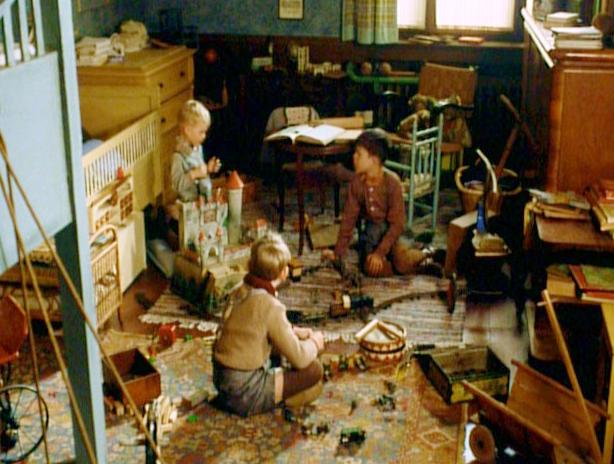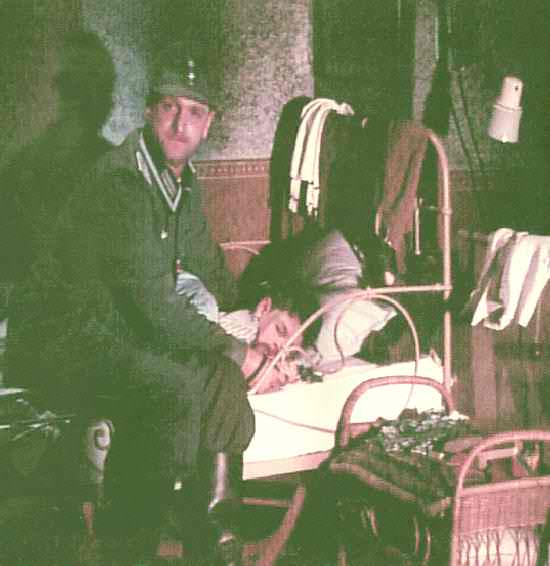

Figure 1.--A German movie set in Berlin during World War II titled "Aimée & Jaguar" (1998). The film depicts an affair between a married German housewife whose husband is a soldier fighting at the front and a Jewish secretary (her ethnic identity is of course concealed) who works for a NAZI newspaper. The story is based on a real-life situation. The costuming is very accurate historically. The boy in the front is wearing short pants with long stockings, but you cant see the leibchen very well. Click on the image for a better example from the film.
|
Aimée & Jaguar (1998)
One garment discussed in the German clothing section was a "Leibchen"--a vest-like garment worn under a boy's shirt to which hose supporters were sewn or otherwise attached. (I don't believe the German boys had safety pins at the tops of their garters as the American boys usually did.) The Leibchen ordinarily buttoned up the back and was apparently made of some sturdy material (jean cloth?) that would take the strain of the attached hose supporters. A leibchen was depicted in a recent German movie set in Berlin during World War II titled Aimée & Jaguar (1998). The film depicts an affair between a married German housewife whose husband is a soldier fighting at the front and a Jewish secretary (her ethnic identity is of course concealed) who works for a NAZI newspaper. The Jewish secretary is secretly engaged in anti-NAZI undercover work and therefore puts herself in great danger. The story is based on a real-life situation and actual historical persons and is extremely interesting. The costuming is very accurate historically.
A Leibchen
A Leibchen was depicted in the film. This is a garment discussed in the German clothing section. It is a vest-like garment worn under a boy's shirt to which hose supporters were sewn or otherwise attached. (I don't believe the German boys had safety pins at the tops of their garters as the American boys usually did.) The Leibchen ordinarily buttoned up the back and was apparently made of some sturdy material (jean cloth?) that would take the strain of the attached hose supporters. This may be the garment which the two cyclists in your pages on German Long Stockings are wearing although one of your German contributors in "Long Stockings: Length" mentions that older boys "had shorter garters fixed at a waist belt similar to that worn by their mothers, but of course without all the adornment of women's garter belts." Note that the stockings are very long in these pictures and that the supporters fasten very high on the leg under very short shorts. Some of these Leibchens appear to have only two garters in front--one for each stocking--while others seem to have four garters--two for each stocking. This latter is apparently the case with the cyclist pictured in "Long Stockings: German Trends--figure 4.¯ You mention that it would be very helpful to obtain pictures of these Leibchens or more grown-up garter belts from some German catalogue of children's clothes from the 1940s or 50s. Perhaps one of your German readers can supply such images. We have few actual images showing a leibchen, but they are depicted in German films with accurate costuming.

Figure 2.-- Later in the film the German soldier returns on leave from the front and discovers that his wife is having an affair with a woman. One scene shows the father sitting on the edge of the bed where one of his sons is sleeping. In the background, hanging over the head of the bedstead, is a Leibchen which the boy will wear the next day to hold his long stockings up.
|
Filmography
Aimée & Jaguar (1998) was set in Berlin during World War II titled ). The film was directed by Max Farberbock.
Setting
The film is set in Berlin at the end of World War II.
Cast
The boy actor is Henrik Meng. He plays one of Mrs. Wust's sons, Albrecht. The two lead roles are "Aimee" (Lilly Wust, played by Juliane Kohler) and "Jaguar" (Felice Schragenheim, played by Maria Schrader).
Plot
The film depicts an affair between a married German housewife whose husband is a soldier fighting at the front and a Jewish secretary (her ethnic identity is of course concealed) who works for a NAZI newspaper. The Jewish secretary is secretly engaged in anti-NAZI undercover work and therefore puts herself in great danger. The story is based on a real-life situation and actual historical persons and is extremely interesting.
The costuming is very accurate historically. The housewife is the mother of several boys who are shown wearing long stockings in winter with their hose supporters showing under their short pants in some cases--once in a Christmas scene in which the children are playing with their toys on the floor and again at the Berlin zoo where they are playing outdoors with toy sail boats (figure 1 and click image). Later in the film the German soldier returns on leave from the front and discovers that his wife is having a lesbian relationship. One scene shows the soldier father sitting on the edge of the bed where one of his sons is sleeping (figure 2). In the background, hanging over the head of the bedstead, is a Leibchen which the boy will wear the next day to hold his long stockings up. It appears to be a white sleeveless vest-like garment to which four rather short hose supporters are attached, presumably two for each stocking. This is the closest I've been able to come to an image of the Leibchen, but it may throw a bit of light on the subject. The costuming also depicts the long stockings that German children still commonly wore.
HBC

Navigate the Boys' Historical Clothing Web Site:
[Return to the Main Charles page]
[Return to the Main Aa-Al alphabetical page]
[Return to the Main long stockings page]
[Introduction]
[Activities]
[Biographies]
[Chronology]
[Clothing styles]
[Countries]
[Essays]
[Theatricals]
[Bibliographies]
[Contributions]
[FAQs]
[German glossary]
[Satellite sites]
[Tools]
[ Boys' Clothing Home]
Created: March 18, 2003
Last updated: 6:31 PM 5/15/2005




